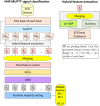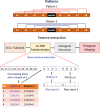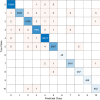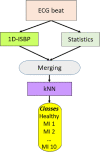Multilevel hybrid accurate handcrafted model for myocardial infarction classification using ECG signals
- PMID: 36467277
- PMCID: PMC9702788
- DOI: 10.1007/s13042-022-01718-0
Multilevel hybrid accurate handcrafted model for myocardial infarction classification using ECG signals
Abstract
Myocardial infarction (MI) is detected using electrocardiography (ECG) signals. Machine learning (ML) models have been used for automated MI detection on ECG signals. Deep learning models generally yield high classification performance but are computationally intensive. We have developed a novel multilevel hybrid feature extraction-based classification model with low time complexity for MI classification. The study dataset comprising 12-lead ECGs belonging to one healthy and 10 MI classes were downloaded from a public ECG signal databank. The model architecture comprised multilevel hybrid feature extraction, iterative feature selection, classification, and iterative majority voting (IMV). In the hybrid handcrafted feature (HHF) generation phase, both textural and statistical feature extraction functions were used to extract features from ECG beats but only at a low level. A new pooling-based multilevel decomposition model was presented to enable them to create features at a high level. This model used average and maximum pooling to create decomposed signals. Using these pooling functions, an unbalanced tree was obtained. Therefore, this model was named multilevel unbalanced pooling tree transformation (MUPTT). On the feature extraction side, two extractors (functions) were used to generate both statistical and textural features. To generate statistical features, 20 commonly used moments were used. A new, improved symmetric binary pattern function was proposed to generate textural features. Both feature extractors were applied to the original MI signal and the decomposed signals generated by the MUPTT. The most valuable features from among the extracted feature vectors were selected using iterative neighborhood component analysis (INCA). In the classification phase, a one-dimensional nearest neighbor classifier with ten-fold cross-validation was used to obtain lead-wise results. The computed lead-wise results derived from all 12 leads of the same beat were input to the IMV algorithm to generate ten voted results. The most representative was chosen using a greedy technique to calculate the overall classification performance of the model. The HHF-MUPTT-based ECG beat classification model attained excellent performance, with the best lead-wise accuracy of 99.85% observed in Lead III and 99.94% classification accuracy using the IMV algorithm. The results confirmed the high MI classification ability of the presented computationally lightweight HHF-MUPTT-based model.
Keywords: ECG signal processing; Local binary pattern; MI classification; Statistical feature extraction.
© The Author(s), under exclusive licence to Springer-Verlag GmbH Germany, part of Springer Nature 2022, Springer Nature or its licensor (e.g. a society or other partner) holds exclusive rights to this article under a publishing agreement with the author(s) or other rightsholder(s); author self-archiving of the accepted manuscript version of this article is solely governed by the terms of such publishing agreement and applicable law.
Conflict of interest statement
Conflict of interestThe authors of this manuscript declare no conflicts of interest.
Figures










Similar articles
-
Multilevel hybrid handcrafted feature extraction based depression recognition method using speech.J Affect Disord. 2024 Nov 1;364:9-19. doi: 10.1016/j.jad.2024.08.002. Epub 2024 Aug 9. J Affect Disord. 2024. PMID: 39127304
-
Cardioish: Lead-Based Feature Extraction for ECG Signals.Diagnostics (Basel). 2024 Nov 30;14(23):2712. doi: 10.3390/diagnostics14232712. Diagnostics (Basel). 2024. PMID: 39682620 Free PMC article.
-
Swin-textural: A novel textural features-based image classification model for COVID-19 detection on chest computed tomography.Inform Med Unlocked. 2023;36:101158. doi: 10.1016/j.imu.2022.101158. Epub 2022 Dec 31. Inform Med Unlocked. 2023. PMID: 36618887 Free PMC article.
-
Application of artificial intelligence techniques for automated detection of myocardial infarction: a review.Physiol Meas. 2022 Aug 3;43(8). doi: 10.1088/1361-6579/ac7fd9. Physiol Meas. 2022. PMID: 35803247 Review.
-
[A review on intelligent auxiliary diagnosis methods based on electrocardiograms for myocardial infarction].Sheng Wu Yi Xue Gong Cheng Xue Za Zhi. 2023 Oct 25;40(5):1019-1026. doi: 10.7507/1001-5515.202212010. Sheng Wu Yi Xue Gong Cheng Xue Za Zhi. 2023. PMID: 37879933 Free PMC article. Review. Chinese.
Cited by
-
Automated characterization and detection of fibromyalgia using slow wave sleep EEG signals with glucose pattern and D'hondt pooling technique.Cogn Neurodyn. 2024 Apr;18(2):383-404. doi: 10.1007/s11571-023-10005-9. Epub 2023 Sep 12. Cogn Neurodyn. 2024. PMID: 38699621 Free PMC article.
-
Leveraging electrocardiography signals for deep learning-driven cardiovascular disease classification model.Heliyon. 2024 Aug 5;10(16):e35621. doi: 10.1016/j.heliyon.2024.e35621. eCollection 2024 Aug 30. Heliyon. 2024. PMID: 39224246 Free PMC article.
-
Improving myocardial infarction diagnosis with Siamese network-based ECG analysis.PLoS One. 2025 Jan 30;20(1):e0313390. doi: 10.1371/journal.pone.0313390. eCollection 2025. PLoS One. 2025. PMID: 39883662 Free PMC article.
References
-
- Visan I. Myocardial infarct inflammation. Nat Immunol. 2018;19:99–99. - PubMed
LinkOut - more resources
Full Text Sources
